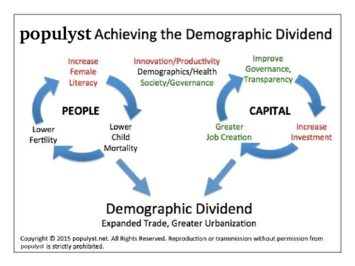
The population of India will have surpassed that of China by the end of this year, with each country counting 1.43 to 1.45 billion people. This milestone has led several observers to wonder whether the Indian economy can achieve a demographic dividend in the same way that China did after 1990. There is however widespread misunderstanding around the question of what constitutes a demographic dividend. This recent statement from a leading Indian daily is typical but inaccurate:
“A high population, especially in a younger age cohort, is generally seen as an asset rather than a liability for the economic fortunes of a country. The simple reason for this is that more people also means more working hands.”
The Financial Times similarly published “Can India Unlock the Potential of its Youth?” in which it discussed India’s prospects of deriving a demographic dividend from its youth bulge.
“More people” or a “youth bulge” could in theory mean “more working hands” but only if there is a sufficient number of jobs being created. The fact that tens of millions of new young cohorts will come of age every year and will need to take jobs to make a living does not automatically mean that those jobs will be there for the taking. A benign economic outcome cannot be taken for granted merely because of a shift in demographics. If for example investment is weak or if literacy is low, having more people may result instead in greater poverty and other deteriorating conditions. In addition if there is a too-large “younger age cohort”, there may be new headwinds slowing the economy in cases where the number of dependents (the young and elderly) overwhelms the number of workers. All of this is to say that while the sheer total number of citizens is important, it is less important than the age distribution of the population and other non-demographic factors.
Elements of a Demographic Dividend
A few years ago, we produced the following chart in an effort to sum up all the elements needed for an economy to achieve a demographic dividend. A demographic dividend is an economic chain reaction or virtuous cycle that is 1) triggered by improvements in literacy, fertility and health, and that is 2) assisted by positive capital flows, job creation and a strengthening of governance and institutions. The necessary ingredients include a PEOPLE component and a CAPITAL component, as shown in the chart. Another way to categorize them is along the populyst Three Pillars of Innovation/Productivity (red), Demographics/Health (black) and Society/Governance (green).
Read the rest of this piece at Populyst.
Sami J. Karam is the founder and editor of populyst.net and the creator of the populyst index™. populyst is about innovation, demography and society. Before populyst, he was the founder and manager of the Seven Global funds and a fund manager at leading asset managers in Boston and New York.
Graph: courtesy Populyst












